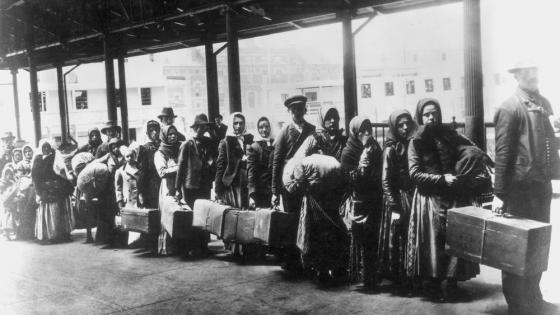Each year, an estimated 2,000 people drowned on their migrant’s journey from Africa to Europe (The Economist 2005) and many more on other routes. Not only is crossing borders illegally a dangerous operation but it also entails very high financial costs. For border crossings such as from Mexico to the US, human smugglers can charge up to $4,000, while trans-pacific crossings of Chinese immigrants to the US cost above $35,000 in the mid-90s and have since increased sharply.
With estimated revenues of around $5 billion a year in the US and €4 billion in the EU (Padgett 2003), people smuggling is a lucrative business. Over the years, it has integrated with other types of illegal activities such as drug shipping and prostitution. Led by international criminal organisations they pose a threat to the rule of law in countries of origin, transit, and destination.
Although it is important for policymakers to understand why these illegal activities and their associated criminalities are so prevalent, there are surprisingly few studies on the supply side of illegal migration (noticeable exceptions are Friebel and Guriev, 2006 and Tamura, 2010, as surveyed by Mahmoud and Trebesch 2010). Yet, it is important to study the industrial organisation of human smuggling, notably smugglers’ pricing and supply of services, to explore what type of economic policies can be implemented to fight against them.
Fighting human smuggling with the right policies
Current migration policies, which combine quotas on visas with repression of illegal migration, are very ineffective instruments to fight against human smuggling. In fact, strong restrictions on labour mobility imply that many candidates are obliged to arrange long distance migration with the help of intermediaries, who organise air, sea or ground transportation and provide them with forged documents, clothes, food and accommodation during the trip. Moreover the empirical literature, which has mostly focused on cross-border migration between Mexico and the US, points to a small or insignificant effect of stricter border controls after the Immigration Reform and Control Act (see for example Hanson 2006 or Gathman 2008).
Since repressive policies are ineffective at eliminating smugglers, a natural idea for economists is to consider basic economic tools, such as price schemes, to fight them by offering candidates the option to pay a fee to cross the border legally. The idea of selling migration visas to regulate migration flows has already fed many debates in the general press, blogs and policy reports (see Becker 2002, 2005, Freeman 2006, Orrenius and Zavodny 2010, Saint Paul 2009 and early discussions by Simon 1989), being strongly criticised by economists such as Banerjee or Mullainathan (The Economist 2010). The opponents of such legalisation argue that the sale of visas may generate a new type of bonded labour between indebted migrants and their employers and that the market does not necessarily allocate resources efficiently (price may be too high or too low depending on externalities entailed by migration). The proponents of legalisation argue that, instead of fuelling the mafia by restricting migration, governments should collect money by selling visas (for instance through auctions). Indeed a business can only be controlled and taxed if it is legal. The government hence realises a double benefit. First it collects new taxes, and second it spends less on repression because mafia organisations are weakened by the legalisation of their business.
Despite the controversy, selling visas has not yet been analysed as a tool to eradicate the smuggling business. One of the concerns raised by Becker’s proposal is that selling visas at the same price as the smugglers or higher will not eliminate them as they may respond to these measures by lowering the price they propose to would-be migrants and still make a profit given their high mark-ups. However, a government could sell visas at a price low enough that smugglers cannot compete. The consequences of this policy in terms of migration equilibrium could be, however, undesirable for a society keen to control the number of immigrants. Whenever the government enters the market by selling visas, migration flows will necessarily increase. Indeed legalisation, entailing risk-free migration and lower discrimination at destination, would become a much more attractive option than illegal migration.
Are policymakers thus facing a trade-off between substantial increases in migration flows and cartelised smugglers? Our work shows that a combination of tools including the sale of visas and various types of repressive measure can be used efficiently in order to fight against smugglers while possibly achieving pre-defined migration targets. Moreover this policy mix may be implemented without weighing too much on public spending, which, given today’s tighter budget constraints, represents an additional desirable feature.
Our idea is to use the funds raised through the sale of visas to finance reinforced repression. Under this scheme, visas will be sold at the price that pushes smugglers out of business. Moreover, by increasing repression, a government makes increases this price. Indeed the increase in migration that will follow this policy will crucially depend on the risk entailed by the illegal crossing and on the degree of discrimination against illegal versus legal migrants on the labour market. The higher is the risk of illegal migration and the lower its payoffs, the higher will be the equilibrium price of visas that pushes smugglers out of business. This scheme will thus allow the government to legalise migration while controlling the number of immigrants.
The success of this policy in not increasing budget deficits while legalising and containing migration flows will therefore depend on the elasticity of demand for illegal migration to enforced repression targeted either at migrants (through deportation) or firms (through sanctions). It will also depend on the elasticity of the smugglers’ operation costs to enforced border controls, which typically varies across countries given the role played by geography in determining these costs. On these parameters, clearly, more evidence is called for.
Sanctions the illegal employers
However, effective migration control combined with legalisation should involve reinforcing sanctions paid by employers of illegal migrants rather than border controls. Today’s discrepancies between investments in external and internal controls are strikingly huge and studies have cast strong doubts on the effectiveness of prevailing border enforcement measures. Moreover new technologies allow firms to verify easily the status of workers before employing them, such as the E-Verify system in the US. Systematic controls of undocumented workers are a much more promising means of controlling illegal migration than border enforcement.
Although this policy will be a more cost-effective way to combine legalisation with migration control than reinforcing border controls, it will typically encounter strong resistance from powerful lobbies as already observed in the US with the E-Verify system, which remains non-compulsory. This also suggests that the status quo reflects complex political-economy issues with some people benefiting more than others from lax enforcement. All these considerations explain why, under current policies, smuggling business is booming and a large number of illegal migrants still bears the costs of being exploited in destination areas and face the constant risk of being deported.
References
Auriol Emmanuelle and Alice Mesnard 2012 "Sale of Visas : A Smuggler's Final Song?" CEPR DP 8965.
Becker Gary, 1992. "An Open Door for Immigrants -- the Auction", Wall Street Journal, Oct 14, 1992.
Becker Gary, 2005. "Comment on immigration policy", Becker-Posner blog, 31 July.
Freeman Richard , 2006. "People flows in globalization", Journal of Economic Perspectives 20 (2): 145-170.
Guido Friebel and Sergei Guriev, 2006. "Smuggling Humans: A Theory of Debt-financed Migration," Journal of the European Economic Association, vol. 4, n. 6, p. 1085-1111.
Gathman, Christina 2008. "Effects of enforcement on illegal markets: Evidence from migrant smuggling along the southwestern border" Journal of Public Economics, Volume 92, Issues 10-11, Pages 1926-1941.
Hanson Gordon H., 2006. "Illegal migration from Mexico to the United Sates" Journal of Economic Literature, 869-924.
Mahmoud, T.O. and C. Trebesch, 2010. "The Economics of Human Tracking and labour Migration: Micro-Evidence from Eastern Europe," forthcoming, Journal of Comparative Economics.
Orrenius Pia M. and Madeline Zavodny, 2010. "Beside the Golden Door U.S. Immigration Reform in a New Era of Globalization" AEI Press.
Padgett, Tim 2003."People Smugglers Inc". Time Magazine, August 12.
Saint Paul, Gilles, 2009, "Immigration, qualifications et marché du travail" La Documentation française. Rapport pour le Conseil d'Analyse Économique, Paris, 2009.
Simon Julian, 1989. The Economic Consequences of Immigration into the United States, Chapter 16, The University of Michigan Press.
Tamura Yuji, 2010: "Human Smuggling", Journal of Public Economics, vol.94, Issues 7-8, pages 540-548.
The Economist, 2005, “Decapitating the snakeheads”, 6 August.
The Economist, 2010, “The price of entry”, 24 June.


